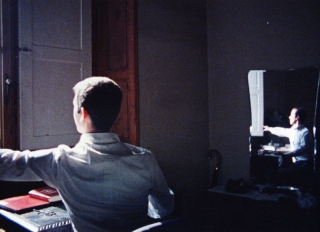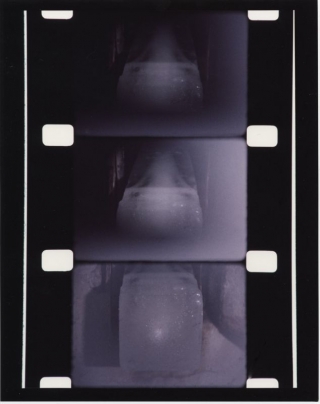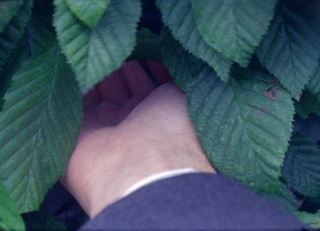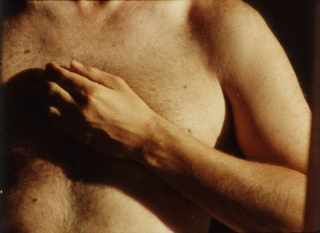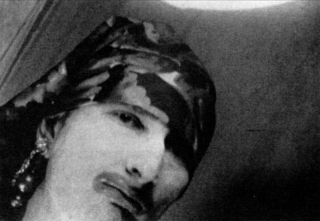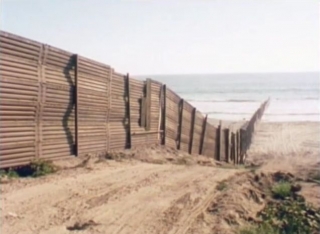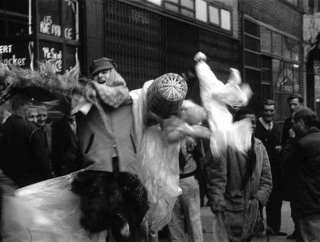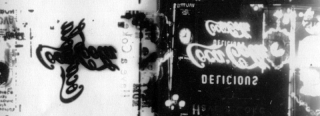Date: 24 February 2007 | Season: Robert Beavers 2007
MY HAND OUTSTRETCHED: PROGRAMME 4
Saturday 24 February 2007, at 2pm
London Tate Modern
Robert Beavers, From the Notebook of …, 1971/1998, 35mm, colour, sound, 48 min
From the Notebook of … was shot in Florence and takes as its point of departure Leonardo da Vinci’s notebooks and Paul Valéry’s essay on da Vinci’s process. These two elements suggest an implicit comparison between the treatment of space in Renaissance art and the moving image. The film marks a critical development in the artist’s work in that he repeatedly employs a series of rapid pans and upward tilts along the city’s buildings or facades, often integrating glimpses of his own face. As Beavers notes in his writing on the film, the camera movements are tied to the filmmakers’ presence and suggest his investigating gaze. (Henriette Huldisch, Whitney Museum of American Art)
Robert Beavers, The Painting, 1972/1999, 16mm, colour, sound, 13 min
The Painting intercuts shots of traffic navigating the old-world remnants of downtown Bern, Switzerland, with details from a 15th-century altarpiece, The Martyrdom of St. Hippolytus. The painting shows the calm, near-naked saint in a peaceful landscape, a frozen moment before four horses tear his body to pieces while an audience of soigné nobles looks on; in the movie’s revised version, Beavers gives it a comparably rarefied psychodramatic jolt, juxtaposing shots of Gregory Markopoulos, bisected by shafts of light, with a torn photo of himself and the recurring image of a shattered windowpane. (J. Hoberman, The Village Voice)
Date: 24 February 2007 | Season: Robert Beavers 2007
MY HAND OUTSTRETCHED: PROGRAMME 5
Saturday 24 February 2007, at 5pm
London Tate Modern
Robert Beavers, Work Done, 1972/1999, 35mm, colour, sound, 22 min
Bracing in its simplicity, Work Done was shot in Florence and the Alps, and celebrates an archaic Europe. Contemplating a stone vault cooled by blocks of ice or the hand stitching of a massive tome or the frying of a local delicacy, Beavers considers human activities without dwelling on human protagonists. Like many of Beavers’ films, Work Done is based on a series of textural or transformative equivalences: the workshop and the field, the book and the forest, the mound of cobblestones and a distant mountain. (J. Hoberman, The Village Voice)
Robert Beavers, Ruskin, 1975/1997, 35mm, b/w & colour, sound, 45 min
Ruskin visits the sites of John Ruskin’s work: London, the Alps and, above all, Venice, where the camera’s attention to masonry and the interaction of architecture and water mimics the author’s descriptive analysis of the “stones” of the city. The sound of pages turning and the image of a book, Ruskin’s ‘Unto This Last’, forcibly remind us that a poet’s perceptions, and in this case his political economy, are preserved and reawakened through acts of reading and writing. (P. Adams Sitney, Film Comment)
Ruskin will be shown in a brand new print. The preservation of this film has been made possible by the generosity of Cineric Inc. and The Guild of St. George.
Date: 25 February 2007 | Season: Robert Beavers 2007
MY HAND OUTSTRETCHED: PROGRAMME 6
Sunday 25 February 2007, at 12pm
London Tate Modern
Robert Beavers, Sotiros, 1976-78/1996, 35mm, colour, sound, 25 min
In Sotiros, there is an unspoken dialogue and a seen dialogue. The first is held between the intertitles and the images; the second is moved by the tripod and by the emotions of the filmmaker. Both dialogues are interwoven with the sunlight’s movement as it circles the room, touching each wall and corner, detached and intimate. (Robert Beavers)
Robert Beavers, AMOR, 1980, 35mm, colour, sound, 15 min
Amor is an exquisite lyric, shot in Rome and at the natural theatre of Salzburg. The recurring sounds of cutting cloth, hands clapping, hammering, and tapping underline the associations of the montage of short camera movements, which bring together the making of a suit, the restoration of a building, and details of a figure, presumably Beavers himself, standing in the natural theatre in a new suit, making a series of hand movements and gestures. A handsomely designed Italian banknote suggests the aesthetic economy of the film: the tailoring, trimming, and chiselling point to the editing of the film itself. (P. Adams Sitney, Film Comment)
Date: 25 February 2007 | Season: Robert Beavers 2007
MY HAND OUTSTRETCHED: PROGRAMME 7
Sunday 25 February 2007, at 2pm
London Tate Modern
Robert Beavers, Efpsychi, 1983/1996, 35mm, colour, sound, 20 min
The details of the young actor’s face – his eyes, eyebrows, earlobe, chin, etc. – are set opposite the old buildings in the market quarter of Athens, where every street is named after a classic ancient Greek playwright. In this setting of intense stillness, sometimes interrupted by sudden sounds and movements in the streets, he speaks a single word, “teleftea”, meaning the last (one), and as he repeats this word, it moves differently each time across his face and gains another sense from one scene to the next, suggesting the uncanny proximity of eroticism, the sacred and chance. (Robert Beavers)
Robert Beavers, Wingseed, 1985, 16mm, colour, sound, 15 min
A seed which floats in the air, a whirligig, a love charm. This magnificent landscape, both hot and dry, is far from sterile; rather, the heat and dryness produce a distinct type of life, seen in the perfect forms of the wild grass and seed pods, the herds of goats as well as in the naked figure. The torso, in itself, and more, the image which it creates in this light. The sounds of the shepherd’s signals and the flute’s phrase are heard. And the goats’ bells. Imagine the bell’s clapper moving from side to side with the goat’s movements like the quick side-to-side camera movements, which increase in pace and reach a vibrant ostinato. (Robert Beavers)
Date: 25 February 2007 | Season: Robert Beavers 2007
MY HAND OUTSTRETCHED: PROGRAMME 8
Sunday 25 February 2007, at 5pm
London Tate Modern
Robert Beavers, The Hedge Theater, 1986-90/2002, 35mm, colour, sound, 19 min
Beavers shot The Hedge Theatre in Rome in the 1980s. It is an intimate film inspired by the Baroque architecture and stone carvings of Francesco Borromini and “St. Martin and the Beggar,” a painting by the Sienese painter Il Sassetta. Beavers’ montage contrasts the sensuous softness of winter light with the lush green growth brought by spring rains. Each shot and each source of sound is steeped in meaning and placed within the film’s structure with exacting skill to build a poetic relationship between image and sound. (Susan Oxtoby, Toronto International Film Festival)
Robert Beavers, The Stoas, 1991-97, 35mm, colour, sound, 22 min
The title refers to the colonnades that led to the shady groves of the ancient Lyceum, here remembered in shots of industrial arcades, bathed in golden morning light, as quietly empty of human figures as Atget’s survey photos. The rest of the film presents luscious shots of a wooded stream and hazy glen, portrayed with the careful composition of 19th century landscape painting. An ineffable, unnameable immanence flows through the images of The Stoas, a kind of presence of the human soul expressed through the sympathetic absence of the human figure. (Ed Halter, New York Press)
Robert Beavers, The Ground, 1993-2001, 35mm, colour, sound, 20 min
What lives in the space between the stones, in the space cupped between my hand and my chest? Filmmaker/stonemason. A tower or ruin of remembrance. With each swing of the hammer I cut into the image and the sound rises from the chisel. A rhythm, marked by repetition, and animated by variation; strokes of hammer and fist, resounding in dialogue. In this space which the film creates, emptiness gains a contour strong enough for the spectator to see more than the image – a space permitting vision in addition to sight. (Robert Beavers)
Date: 31 March 2007 | Season: London Lesbian & Gay Film Festival 2007 | Tags: Ken Jacobs, London Lesbian & Gay Film Festival
FLAMING CREATURES & BLONDE COBRA
Saturday 31 March 2007, at 6.10pm
London Lesbian & Gay Film Festival at BFI Southbank
Jack Smith, Flaming Creatures, USA, 1963, 16mm, black and white, sound, 42 min
Ken Jacobs, Blonde Cobra, USA, 1959-63, 16mm, black and white & colour, sound, 33 min
Two gloriously primitive flicks which define and transcend the idea of “underground” film. Flaming Creatures, Smith’s impoverished, epic fantasy of Babylonian proportions, is a decadent celebration of the joy and torment of existence. This bleached-out orgiastic rite, all limp penises and shaking breasts, is populated by a blonde vampire, exotic Spanish dancers and androgynous bohemian poseurs. Blonde Cobra, as close to an authentic portrait of Smith that we have, is propelled by a delirious monologue (witness the scurrilous tale of Madame Nescience and Mother Superior) and was shot amongst the rubble of his apartment. The two films were premiered together in April 1963, and remain fresh, provocative and startlingly original over 40 years later. (Mark Webber)
PROGRAMME NOTES
FLAMING CREATURES & BLONDE COBRA
Saturday 31 March 2007, at 6.10pm
London Lesbian & Gay Film Festival at BFI Southbank
Jack Smith’s Flaming Creatures and Ken Jacobs’ Blonde Cobra (in which Smith stars) are two gloriously primitive flicks which define and transcend the idea of “underground” film. We can only begin to imagine the extraordinary reactions they might have caused in audiences of the early 1960s.
FLAMING CREATURES
Jack Smith, USA, 1963, 16mm, b/w, sound, 42 min
Flaming Creatures, an impoverished, epic fantasy of Babylonian proportions, supposedly caused riots at early screenings. Viewers were incensed not so much by what they saw, but for the lack of graphic pornography, which they expected from such an international cause célèbre. Smith’s polymorphous vision, all limp penises and shaking breasts, is something decidedly other: A bleached-out orgiastic rite populated by androgynous creatures (exotic Spanish dancers, bohemian poseurs and a blonde vampire), and a decadent celebration of the joy and torment of existence.
BLONDE COBRA
Ken Jacobs, USA, 1959-63, 16mm, b/w & colour, sound, 33 min
Blonde Cobra, made by Ken Jacobs from footage abandoned by Bob Fleischner, is as close to an authentic portrait of Smith that we have. Shot mostly amongst the rubble of his apartment and propelled by a delirious monologue (witness the scurrilous tale of Madame Nescience and Mother Superior), its freewheeling anti-form mixes image with black leader, recorded sound with live radio. Both films were premiered together in April 1963, and remain fresh, provocative and startlingly original over 40 years later. “Life swarms with innocent monsters.” (Charles Baudelaire)
Back to top
Date: 1 April 2007 | Season: London Film Festival 2006 | Tags: London Film Festival
LONDON FILM FESTIVAL EXPERIMENTA TOUR 2007
April–June 2007
UK touring programme
An essential part of The Times BFI London Film Festival each year, Experimenta is the place to discover innovative and challenging cinema. It explores a wide range of personal expression through the work of international film and video makers, from unconventional narrative features to contemporary artists’ moving image. The 2007 edition of the annual Experimenta Tour presents some of the highlights from last year’s programme.
The Festival’s 50th anniversary was an appropriate moment to celebrate the work of Kenneth Anger, one of the most distinctive and distinguished artists in the history of cinema, who made his first film, Fireworks, as early as 1947. For the touring programme, Anger’s recent video Mouse Heaven joins four of his classic films in “Cinema as Magick Weapon,” a selection that spans six decades of extraordinary and uncompromising creativity. In the documentary portrait Anger Me, the aker tells his own story, enhancing an already legendary mythology with anecdotes on his life and work.
With a theme of adolescent longing and sexual awakening reminiscent of Anger’s debut, Wild Tigers I Have Known is the first feature by director Cam Archer. This highly stylised film charts the coming of age of a young gay teenager in a haze of colourful reverie, replete with dreamy visuals and atmospheric music.
“Travelling Light”, a programme of 16mm films in which three artists respond to diverse locations, demonstrates that the film medium is not yet defunct, despite widespread migration towards digital and new media. Nick Collins documents a lush valley in the South of France, whilst Ben Rivers ventures to the Scottish Highlands. Bill Brown traces the border between the USA and Mexico, often fixing his camera on the vast expanse of desert. The landscape is infused with political tension, a subject addressed by the undocumented immigrants and border activists that are heard on the soundtrack of this illuminating essay film.
ANGER ME
Ello Gelmini, Anger Me, Canada, 2006, 72 min
CINEMA AS MAGICK WEAPON: THE FILMS OF KENNETH ANGER
Kenneth Anger, Fireworks, USA, 1947, 15 min
Kenneth Anger, Rabbit’s Moon, USA-France, 1950-79, 7 min
Kenneth Anger, Scorpio Rising, USA, 1963, 29 min
Kenneth Anger, Mouse Heaven, USA, 2005, 10 min
WILD TIGERS I HAVE KNOWN
Cam Archer, Wild Tigers I Have Known, USA, 2005, 81 min
TRAVELLING LIGHT
Nick Collins, Across The Valley, UK, 2006, 20 min
Ben Rivers, This is My Land, UK, 2006, 8 min
Bill Brown, The Other Side, USA, 2006, 43 min
Selections from these programmes screened at Edinburgh Filmhouse, Glasgow Film Theatre, Manchester Cornerhouse, and London ICA.
Date: 3 April 2007 | Season: London Lesbian & Gay Film Festival 2007 | Tags: Jack Smith, Ken Jacobs, London Lesbian & Gay Film Festival
TWO WRENCHING DEPARTURES
Tuesday 3 April 2007, at 8pm
London Roxy Bar and Screen
Secret Cinema presents a free screening of a major new work by Ken Jacobs.
In his amazing live performances, Ken Jacobs breathed new life into archival film footage, teasing frozen frames into impossible depth and perpetual motion with two 16mm analytic projectors. Now aged 74, the artist explores new ways of documenting and developing his innovative Nervous System techniques in the digital realm.
Two Wrenching Departures, featuring the legendary Jack Smith (both clownish and devilishly handsome circa 1957), extends five minutes of material into a ninety-minute opus of eight movements. In and out of junk heap costume, Smith cavorts through the streets of New York (much consternation from the normals) and performs an impossible, traffic island ballet.
His improvised actions are transformed into perceptual games as Jacobs’ interrogates his footage, using repetition and pulsating flicker to open up new dimensions and temporal twists: The infinite ecstasy of little things. In commemorating two dear departed friends, with whom he collaborated on Blonde Cobra and other works, he propels their image into everlasting motion. These mindbending visions are juxtaposed with the soundtrack of The Barbarian, a 1933 Arabian fantasy starring Ramon Navarro and Myrna Loy, and music by Carl Orff.
TWO WRENCHING DEPARTURES
Ken Jacobs, USA, 2006, video, b/w, sound, 90 min
“In October 1989, estranged friends Bob Fleischner and Jack Smith died within a week of each other. Ken Jacobs met Smith through Fleischner in 1955 at CUNY night school, where the three were studying camera techniques. This feature-length work, first performed in 1989 as a live Nervous System piece is a ‘luminous threnody’ (Mark McElhatten) made in response to the loss of Jacobs’ friends.”
Ken Jacobs (born 1933) is one of the key figures of post-war cinema, whose films include Little Stabs at Happiness (1958-60), Blonde Cobra (1959-63), Tom Tom the Piper’s Son (1969-71), The Doctor’s Dream (1978), Perfect Film (1986) and Disorient Express (1995). He has also presented live cine-theatre (2D and 3D shadow plays) and developed the Nervous System and Nervous Magic Lantern projection techniques. Since 1999, Jacobs has primarily used electronic media, both in preserving his live performances and creating new digital works in a variety of styles. His 7-hour epic Star Spangled To Death (1957-2004) is now available on DVD from Big Commotion Pictures.
Free admission. No reservation necessary, but arrive early to avoid disappointment.Please note that this screening is not suitable for those susceptible to photosensitive epilepsy due to the extensive use of flickering and throbbing light.
Related Events
Ken Jacobs’ 1963 film Blonde Cobra will screen with Jack Smith’s Flaming Creatures in the London Lesbian & Gay Film Festival on Saturday 31st March 2007 at 6.10pm.
Mary Jordan’s documentary Jack Smith and the Destruction of Atlantis also shows in the festival in the same day.
Back to top
Date: 13 April 2007 | Season: Swingeing London
SWINGEING LONDON
13-19 April 2007
Filmhuis Den Haag
For a few years after the Beatles first shook Britain out of the Dark Ages, it seemed like London was the place to be. Maybe the seeds of this cultural Renaissance were sown a little earlier, towards the end of the 1950s with the Free Cinema movement, and British Pop Art, first seen in “This Is Tomorrow” at the Whitechapel Gallery in 1956. Artist Richard Hamilton, who had created the iconic collage “Just What Is It That Makes Today’s Homes So Different, So Appealing?” for that exhibition, produced a series of prints titled “Swingeing London”, which reproduced a newspaper photo of his hip gallerist Robert Fraser handcuffed to Mick Jagger following their arrest for drug possession in 1967. By this time, England’s capital city had been characterised as ‘Swinging London’ by Time Magazine, and the artist’s satirical play on words references the severity of the sentence bestowed on Fraser by the fearful establishment.
At the end of the decade, Hamilton collaborated with filmmaker James Scott on an eponymous self-portrait that perfectly encapsulates the artist’s spirit and sources of inspiration. The exuberant film is featured in this season which explores the embryonic counterculture that developed as ‘flower power’ blossomed and faded. As counterpoint to the feature films screening in the “Swinging London” series, “Swingeing London” excavates the underground.
It took the presence of a few key Americans in London to really get things cooking. William Burroughs lived in London from 1966-74, and had already made Towers Open Fire together with exploitation film distributor Antony Balch. The film remains the purest cinematic realisation of Burroughs’ distinct writing style. New Yorker Stephen Dwoskin was one of the founding members of the London Film-Makers Cooperative, and his fellow countryman Peter Gidal was a central figure of that organisation throughout the 1970s. Kenneth Anger lived in London after exiling himself from the US in 1967, a move prompted in part by his opposition (and fear) of the war in Vietnam, the same motive that brought Carolee Schneemann across the Atlantic. Another part-time Brit was Yoko Ono, who often resided in the apartment of artist John Latham, and famously bagged herself a Beatle.
With a little encouragement, the English shook off their innate reserve and embraced the new freedom and prosperity that modern life had to offer. London played host to several indicative and fundamental gatherings of the tribes – the International Poetry Congress at the Royal Albert Hall in 1965 (featuring Ginsberg, Ferlinghetti, Trocchi, documented in Peter Whitehead’s amazing verité Wholly Communion), the Destruction in Art Symposium (very little footage circulates from this 1966 performance series), and the Dialectics of Liberation psychology conference of 1967 (captured in the documentary Anatomy of Violence by Peter Davis). The music scene was a central focus, with concerts such as the 14 Hour Technicolor Dream Festival at Alexandra Palace (1967) and the free Rolling Stones show in Hyde Park (1969).
As portable 16mm equipment made cinema a more affordable and impulsive medium, many of these events were documented on film. As in the USA, where Andy Warhol, Jonas Mekas, Bruce Conner and others were already using cinema as a mode of personal artistic impression, British filmmakers soon moved in this direction. Inspired by a similar organisation in New York, the London Film-Makers’ Co-operative was founded by a group of enthusiasts in 1966. Initially a film society that met in the basement of the progressive Better Books shop to view the classics of world cinema (this is before alternative distribution circuits, vhs or dvd), the LFMC soon developed into a dynamic centre for the exploration of film as an art medium under the guidance of Dwoskin, Gidal, Malcolm Le Grice and others.
During this formative period ‘underground films’ were often to be seen projected before or during concerts by bands such as the Pink Floyd or Soft Machine at the UFO (Unlimited Freak Out) club or at all-night raves in the dilapidated Roundhouse. Artists Mark Boyle and Joan Hills (of the Boyle Family) formed the Sensual Laboratory, developing their experimental slide shows, which were already being performed in an art context, into full-blown complements to psychedelic rock concerts. Unlike the American light shows, Boyle and Hills’ visuals operated independently of the music, rather than being a synchronous, visual accompaniment to it.
Photographer John ‘Hoppy’ Hopkins, a legendary figure on the London scene, was a founder member of IT (the counterculture newspaper International Times), UFO, the Notting Hill Festival and the London Free School. Despite this central organising role, he spent the Summer of Love in jail for marijuana possession. The recently rediscovered short film Poem for Hoppy shows Soft Machine and the Sensual Laboratory collaborating on an improvised howl of support.
After his release, Hoppy turned to the new medium of video, using one of the earliest Sony Portapaks. Working together with the TVX collective, he attracted the attention of the BBC and was invited into the studios of Television Centre to perform a live videomix happening with a group of artists, musicians and freaks. Videospace was not broadcast, but a surviving excerpt demonstrates some of the visual invention and playful creativity that took place at this unique event. Lutz Becker also experimented with the new video technology, creating feedback loops for Horizon, a work covered in detail in Gene Youngblood’s book “Expanded Cinema” but rarely seen today.
Though psychedelia dominated the pop scene, few films made in England in the sixties could truly be described as psychedelic. Mare’s Tail is a prime exception – a long, strange trip into inner space made by maverick filmmaker and photographer David Larcher. Mare’s Tail is a two and a half hour, abstract journey deep within. It was the first film shown in the cinema at the New Arts Lab (aka the Institute for Research in Art and Technology), where it ran for two successful weeks.
The original Arts Lab, on Drury Lane in the heart of Covent Garden, had been established by Jim Haynes and Jack Henry Moore in 1967. Incorporating a café, bookstore, gallery, theatre and cinema within a single building, the Arts Lab provided a venue and meeting point for different artistic groups. Haynes, another American who galvanised London’s counterculture, was also a co-founder of International Times and the Amsterdam based sexual freedom newspaper SUCK! All scenes feed into eachother.
The naïveté and optimism of this underground explosion didn’t last for long. In the US, Woodstock failed to live up to its promise and Altamont turned the hippie dream into a homicidal nightmare. England had Phun City and the Isle of Wight Festivals: No fatalities, but they were disastrously organised and showed that the idealistic hopes of the sixties generation were unsustainable without some form of structure to balance the spontaneity. As the ‘white heat of technology’ cooled down, unemployment set in and, during the seventies, glitter was liberally applied to cover the cracks in the youth culture.
SWINGEING LONDON 1: Sat 14 Apr & Tue 17 Apr 2007
SWINGEING LONDON 2: Sun 15 Apr & Wed 18 Apr 2007
SWINGEING LONDON 3: Sun 15 Apr & Thur 19 Apr 2007
SWINGEING LONDON 4: Fri 13 Apr & Mon 16 Apr 2007
SWINGEING LONDON is curated by Mark Webber.
Back to top
Date: 13 April 2007 | Season: Swingeing London
SWINGEING LONDON: 4
Friday 13 April 2007, at 9pm
Filmhuis Den Haag
Introduction by Mark Webber
POEM FOR HOPPY
Boyle Family, UK, 1967, 16mm, colour, sound, 4 min (shown on video)
An improvised performance, by Soft Machine and the Sensual Laboratory, in protest against John Hopkins’ conviction for marijuana possession.
“Mark Boyle and Joan Hills lived in and around Ladbroke Grove in the middle 1960s, organising events and making sculptures that attempted to present reality as it is. The events included various projection pieces presenting physical and chemical change: boiling water, burning slides and bodily fluids that led to them being asked by Hoppy to do a presentation at the first night of the UFO club, where their liquid light of exploding colours became the main visual accompaniment to the bands that performed there. Pink Floyd, Soft Machine, Jimi Hendrix, the underground scene and psychedelic lightshows exploded out of UFO, across London and around the world.” (Portobello Film Festival)
MAJA REPLICATE
Fred Drummond, UK, 1969, 16mm, colour, silent, 15 min (double screen projection)
Maja Replicate is a freewheeling collage of disparate materials assembled through visual and technical improvisation in the LFMC workshop.
“A multi-coloured reprint using diary material, found footage of a male and female scientist (much decayed), Claudette Colbert from Siren of Atlantis, a glamorous model and a film of the Phun City festival. The structure, a conglomeration of fades, stills, repeats, loops and slipping footage was the result of a process of physical rapport with the film co-op printing machine. Basically an over-ripe colour concoction. I enjoyed making it!” (Fred Drummond)
CHOKE
David Crosswaite, UK, 1971, 16mm, b/w & colour, sound, 5 min (double screen projection)
Driven by a live recording of “Crossroads” by Cream, Choke is a positive/negative, Pop Art explosion across two screens. The title takes a dig at Coke, whose huge neon sign at Piccadilly Circus provides most of the raw material, which is dynamically animated, superimposed, mirrored and inverted.
SOUL IN A WHITE ROOM
Simon Hartog, UK, 1968, 16mm, colour, sound, 3 min
LFMC founder member Simon Hartog was one of the most politically aware filmmakers of the period. This early short film is an amusing piece of social commentary on mixed race relationships, which were hardly commonplace in the UK at that time, and has a soundtrack by The Troggs. The male character played by Omar Dop-Blondin, a Sengelese student fresh from the Paris 68 protests, and an associate of the London Black Panthers.
NAISSANT
Stephen Dwoskin, UK, 1964-67, 16mm, b/w, sound, 14 min
Dwoskin’s early films were heavily influenced by Warhol, in both the visual content and extended duration. They typically consisted of long takes from a fixed or hand-held camera, with an attractive young woman as the only protagonist. Composer Gavin Bryars provided the soundtrack to Naissant and several others.
“Objective location: a bed; subjective location: in thoughts. Being with thoughts and the child to be born. Camera from three sides of the bed with three lenses working from bed level and standing level. Filmed in New York in 1964, completed in London 1967. Naissant presents being alone with one’s thoughts. Time and her inner thoughts are found out only by spending time with her in the film.” (Stephen Dwoskin)
VIDEOSPACE REEL
John Hopkins / TVX, UK, 1970, 16mm, colour, sound, 15 min (shown on video)
This recently rediscovered reel of early video image processing by John Hopkins and the TVX collective begins with a music “visualisation” made for the BBC to accompany the track “Scotland” by Area Code 615. The remaining footage is an excerpt from the Videospace happening which took place inside a BBC TV studio: an un-broadcast optical dub session which incorporated music, tape, film and feedback loops, lightshows, dancing, inflatables and live video mixing.
HORIZON
Lutz Becker, UK, 1968, 16mm, colour, sound, 5 min
Beginning in 1966, Lutz Becker and BBC engineer Ben Palmer collaborated on a sequence of works in their quest to create “electronic moving pictures”. The calligraphic forms seen in Horizon were generated by feedback loops between cameras and monitors, with colour added later on a conventional optical printer. The music was composed and performed by cellist Joy Hall.
PAPERCITY
John Bennett, UK, 1969, 16mm, colour, sound, 5 min
Papercity builds an impressionistic portrait of London through still photographs and timelapse footage. Views of the city rarely feature in experimental films of this period, but this semi-commercial production, funded by the British Film Institute, is an evocative study of everyday sights and activities.
Also Screening: Monday 16 April 2007, at 8:30pm
Back to top
